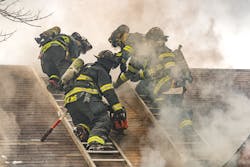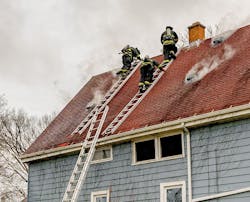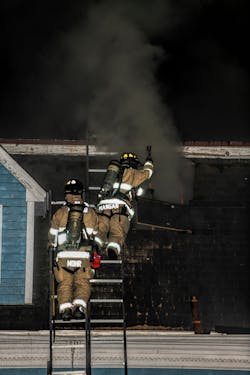Truck Tactics: Ventilation Techniques for Steep Roofs
Vertical ventilation is a critical benchmark of many departments’ fireground operations for residential and commercial occupancies. However, when the roof pitch goes from flat or shallow to steep, which produces a situation where members can’t maneuver or walk easily, the comfort level of many firefighters and officers can wane, and the ventilation that’s needed often is forgone. This can be the difference in the interior crews being able to make the push or having to back out.
The typical 4 x 4-foot and 4 x 8-foot square and 1-2-3-4 cut sequence that are the staples of roof ventilation very often aren’t applicable on steep roofs. Thus, you must know how to switch tactics when you encounter a steeply pitched roof.
From an aerial
Often, a roof might be so steep that operating on it, even with a roof ladder, simply isn’t an option. In this case, you might elect to vent off of an aerial ladder, platform or bucket if it’s available. However, heading up on the aerial isn’t the time to consider how to vent from the aerial. A truck crew and/or the crew that will make the cut must go up with a plan for hole type, cut sequence and how it will cut off of the aerial.
Once the aerial device is positioned and ready, the crew should position the ladder tip or bottom of the platform or bucket within several inches of the roof near to where the vent hole is desired.
A crew only should operate with the ladder tip in a supported position when the apparatus manufacturer’s operating instructions and department standard operating guidelines allow for it.
Once the aerial is in place, the cutting member tethers him/herself to the ladder tip, platform or bucket via a ladder belt that has a long attachment. This allows the cutting member to lean out away from the aerial and over the roof to operate the saw.
Note: If a ladder belt that has a long attachment isn’t available, the member of the crew who is doing the cutting can position with one foot on the edge of the aerial device and one foot on the roof. In this case, it’s absolutely essential that the second member remains with a firm handhold on the cutting member so that the cutting member doesn’t fall off as cuts are made.
Given that the cutting member is tethered to the aerial and won’t have the range of motion that’s typical on a flatter roof, the cut sequence and the hole type might need to be adapted. If the cutting member is unable to reach to make a rectangular cut, the next best option is a triangular cut. The cutting member makes a triangular cut, with the peak of the triangle positioned toward the peak of the roof: two angled cuts that meet at the peak of the triangle, followed by two cuts to make the bottom of the triangle. Louver cuts then assist with opening up and removing the roof materials in the effort to obtain efficient lift.
After the the process of cutting the louvers is complete, the cutting member returns the chainsaw to the aerial, and the second member uses a long pike pole to ensure that all of the sheetrock is punched down, to allow for vertical rise.
Milwaukee cut
The Milwaukee vertical ventilation cut, which was invented by members of the Milwaukee Fire Department, involves using dual roof ladders in the process of producing the ventilation hole.
The roof ladders are placed parallel to each other approximately four feet apart, with their hooks over the ridge. A member on each ladder uses a saw to cut a vertical seam that runs parallel to each ladder beam that’s closest to the hole. They cut down four feet, then across two feet at the bottom of their vertical cut to meet with the intersecting cut of the opposing team member’s saw.
If the roof has a ridge vent and the members who are carrying out the cutting begin their work at the ridge, they won’t need to make a cut at the top, given that the ridge vent acts as a cut.
After the hole is cut, the members can pull the cut roof section down and out. Depending on the need, they might continue the cut to increase the opening size. The members use a hook or pike pole to ensure that the sheetrock is pushed down.
Vertical coffin cut
Depending on the equipment that’s available, crews might have access to multiple roof ladders. However, if the length of the roof exceeds the length of the roof ladder, crews might have to utilize only one ladder. In the case of the latter circumstance, the butt of the roof ladder should be butted up to the beams of a roof access ladder to maintain stability without it sliding off. A firefighter should remain at the top of the roof access ladder while members make the vent hole, to ensure that the roof ladder doesn’t dislodge while crews operate off of it.
The first crew member should ascend the ladder and make the first (top) horizontal cut. (If there’s a ridge vent in place and the member can reach it, it can be used in lieu of the top horizontal cut.) The top cut should be approximately two feet long—or what the member can reach without overextending. After the top cut, the cutting member makes the outside vertical cut (four feet). The member who is positioned below the cutting member should have a hook that can be embedded in the roof material near the cutting member’s feet, to allow for an impromptu foot placement if the cutting member must step out onto the roof to make the furthermost cut.The member of the crew who is doing the cutting then repositions to make a parallel vertical cut that’s near the ladder beam.
Lastly, the bottom cut is made, and the roof membrane can be louvered.
The bottom cut might not be needed when the roof sheathing is standard oriented strand board roof decking material. Blunt force should be more than enough to break the remaining uncut two feet.
The same process is completed a second time to increase the size of the opening to 8 x 2 feet. This gives you the same square footage of vent space as a traditional 4 x 4-foot hole.
If needed, crews can extend the cut (depending on the length of the roof), or they can duplicate the first cut on the opposite side of the ladder.
Varied skill set
As with everything else in the fire service, members must be able to problem-solve and take into account conditions, building construction and variances to get the job done. No fire is the same. That’s why it’s so important to train on different techniques. That way, when it’s time to perform, firefighters can bring experience and training to bear to complete the evolution.
About the Author

Zachary Brown
Zachary Brown is a captain at the DeKalb County, GA, Fire Rescue Department (DCFR). He has been in the fire service for 15 years, the past 12 of which have been with the DCFR. Brown is a paramedic and has been a member of the DCFR technical rescue and dive teams.


